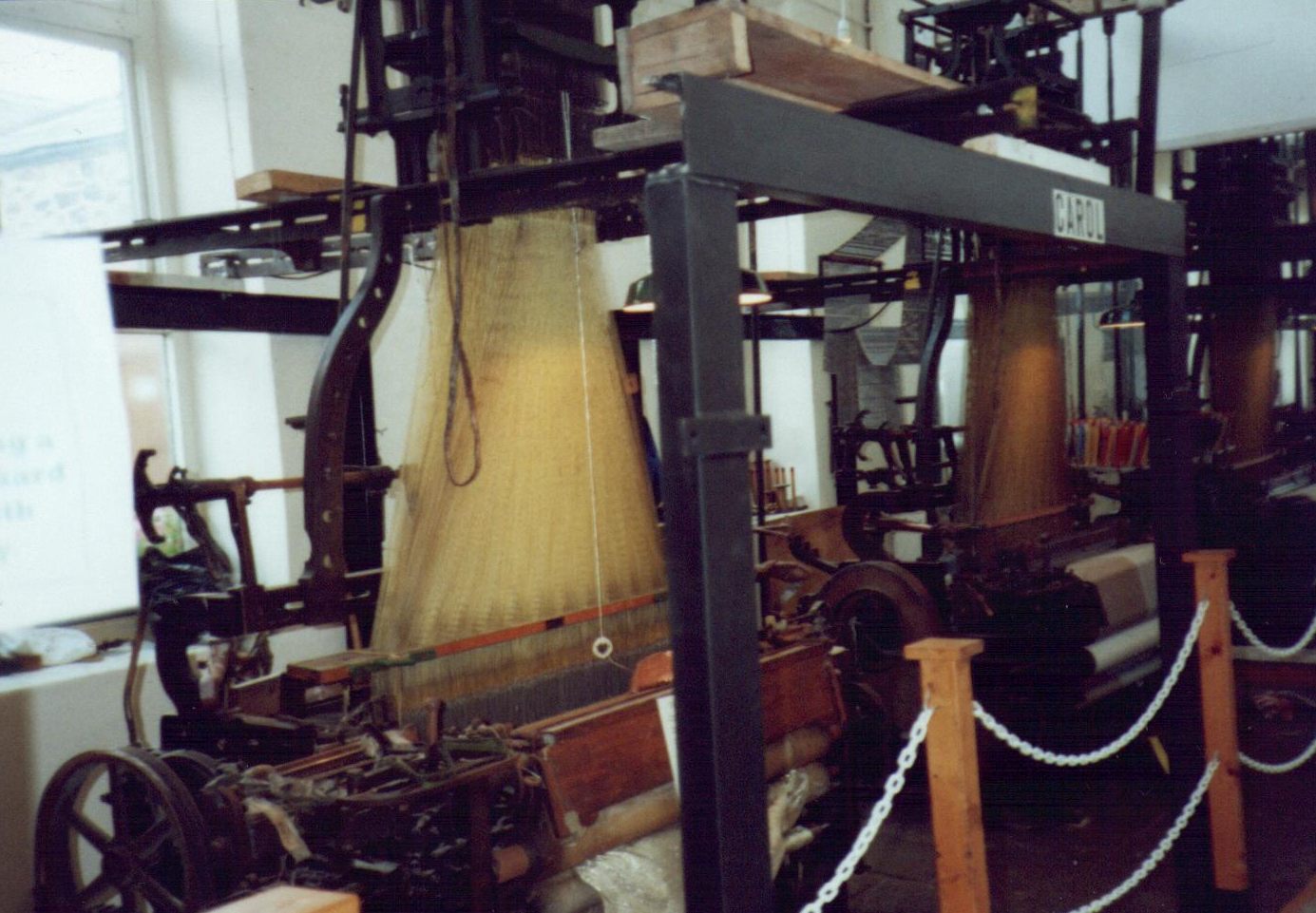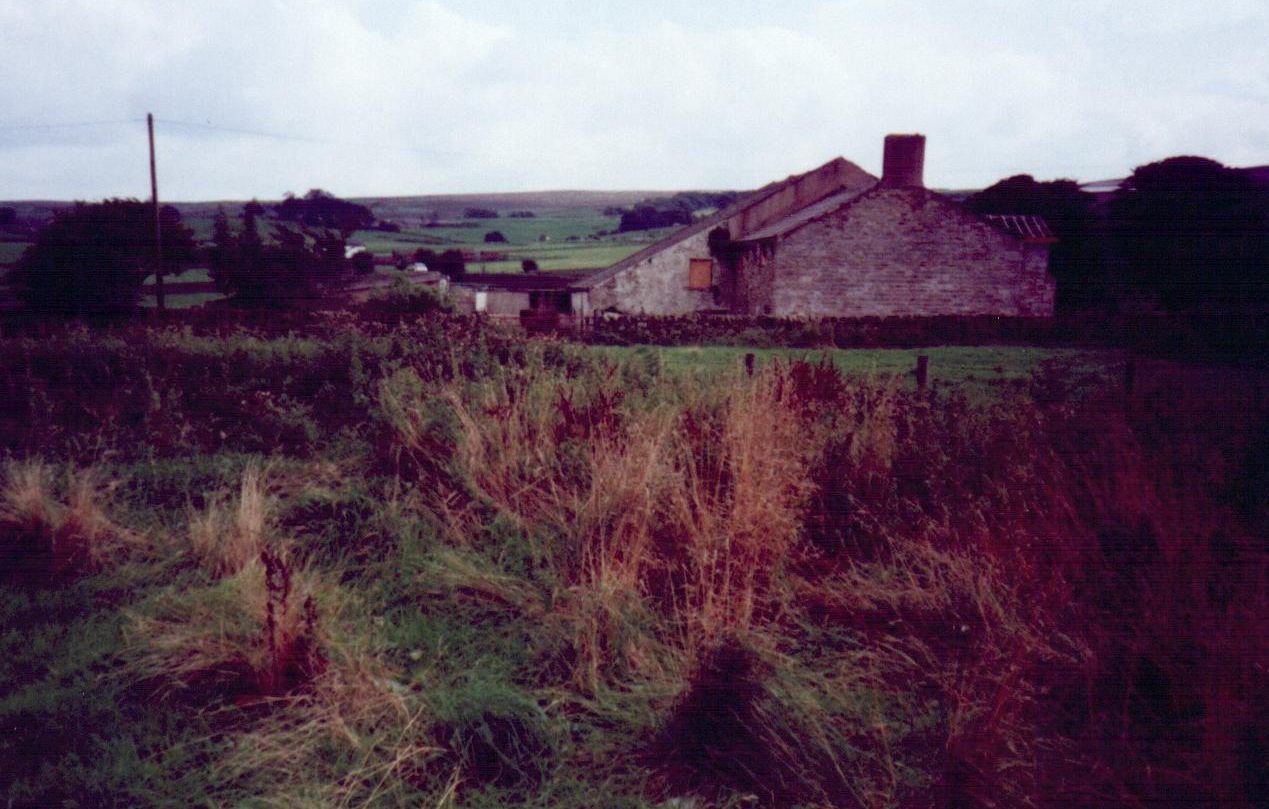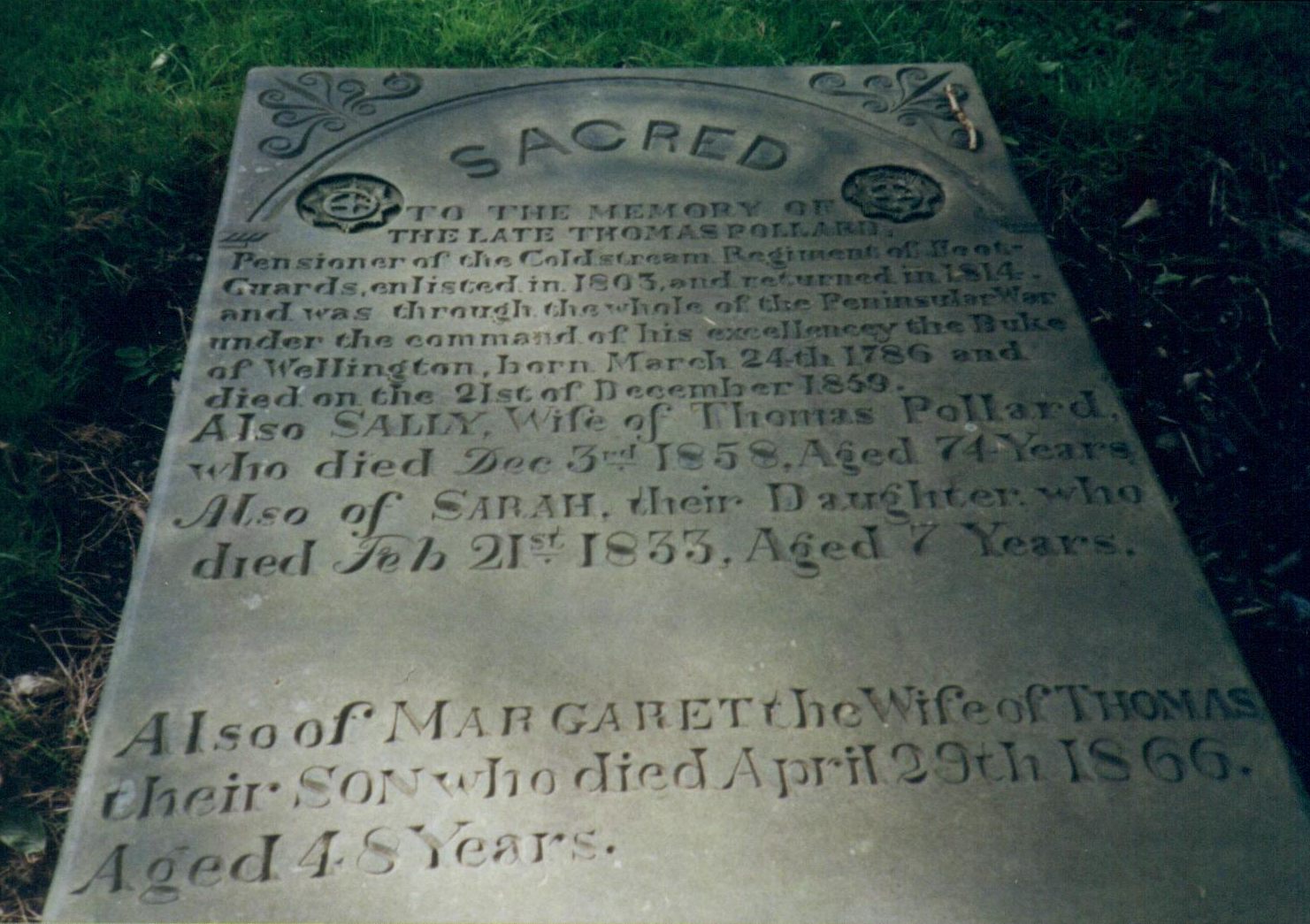John Grimshaw’s Life After His Discharge from the Coldstream Guards
Webpage for John Grimshaw,Coldstream Guards Soldier and Lancashire Weaver
This companion webpage to “John Grimshaw, Coldstream Guards Soldier and Lancashire Weaver” describes John’s life after his discharge from the Guards. Included in this description are the following topics:
Contents
Website Credits
Thanks go to Anne Grimshaw for providing the following information on John Grimshaw’s life after his discharge from the Coldstream Guards:
War, as always, had made vast profits for some and left others in misery. When “dispensed with”, former soldiers and sailors returned home. Gone was the demand for cloth for uniforms, guns and leather. Mills and factories that had supplied the army (and navy) were now too big for peace-time needs. There was no need for investment, capital lay idle, profits dropped and employment fell. Slump followed and unemployment hung over Britain, made worse by the returning half million men and a subsequent, if mild, ‘baby boom’.
John was, perhaps, slightly better off than most for his service in the army had continued for three and a half years after the end of hostilities. He had thus been somewhat protected from the immediate effects of the Corn Laws passed in 1815 which, effectively, put up the price of bread. This protected landlords and farmers but hit the increasing numbers of factory workers and the unemployed hard.
It was not surprising that there was civil unrest. Discontent had been simmering while John had been away fighting in the Peninsula and had culminated in bouts of machine-breaking by the Luddites in 1811-12 and again in 1815-16. It was to flare up again ten years later right on John’s doorstep.
John had been home just over seven months when news came that the cavalry of the 15th Hussars had, on government orders, charged a crowd of what would now be called demonstrators, on St Peter’s Fields, Manchester, in August 1819 causing eleven deaths and hundreds injured. It had been dubbed the Peterloo Massacre.
Amongst them were many hand-loom weavers, like John, vainly struggling to compete with machinery, unemployment, and a rise in bread prices. Amongst them also were former soldiers, once upholders of Britain but now disgruntled and disillusioned.
When John returned home he too would have found himself desperately trying to fit into a way of life that had changed from one that he had known as a boy and one that he had known as a soldier. With a disability, John must have found life hard. Was he denied a hero’s welcome for the battle of Waterloo had been over three-and-a-half years by the time John came home? Had life been better in the army?
But was he, at least, welcomed home by his brother-in-law, Thomas Pollard, also an old Coldstream Guardsman with whom he could swap stories and remember the old days in the Peninsula? Perhaps they would meet for a beer or two that might temporarily blot out the ever-changing present and bring back memories of tramping along in Spain, Portual and the Low Countries to the jaunty tune of Over the hills and far away.
When Johnny Comes Marching Home Again
When John Grimshaw was discharged from the Coldstream Guards in December 1818, he went home and literally picked up the threads of his pre-war life as a hand-loom weaver. Home was the village of Church in Lancashire. But it was rapidly becoming a very different place from the Church that John had known as a boy. The tentacles of the Industrial Revolution were gradually enveloping places such as Church, Oswaldtwistle, Darwen and Haslingden, not to mention towns such as Blackburn and Accrington, in an ever-tightening grasp from which there was no escape.
The war was over and fuelling the army with the products of iron foundries, woollen mills, boot factories and so on was no longer profitable and many closed putting thousands out of work. Added to those newly unemployed were soldiers, like John Grimshaw, returning home. Hardly surprising that many were antagonistic towards the government.
When John returned from the army in December 1818 he found many changes—changes which he perhaps did not care for but which altered the character of Church from that which he had known as a boy.
In the 1830s coal mines at Park Pits and Coppy Clough began operation and a couple more followed twenty years later. Between them they employed about 300 people—almost the same as the entire population of Church when John had left in 1806.
Along with the coal mines came the chemical works. Established to meet the needs of the textile industrial was the refining natural indigo for dyeing, especially calico, which was the staple of the area but others followed: glues, acid, soap, explosives and oils. Later came iron foundries, engineering, quarrying.
In 1836, Hargreaves’ Brothers of nearby Accrington built a fine four-storey warehouse with a central arch leading to the canal wharf that was busy with goods in and out.
By the time John was forty there were more machines in Lancashire than in the rest of the world put together.
John was fifty-eight when the Church branch of the East Lancashire Railway opened in 1848—just eighteen years after the first passenger-carrying locomotive, Stephenson’s Rocket, had made its world-changing run from Liverpool to Manchester amid much celebration, in Liverpool at least. Then, the hero of Waterloo and now Prime Minister, the Duke of Wellington, had been on board.
But not everyone was delighted with Rocket. Its arrival in Manchester in 1830, just four years after the hand-loom weavers had smashed new power looms in East Lancashire in an effort to defend their livelihoods, was seen as a menace that heralded unwelcome change—yet another machine that threatened to change their lives forever.
This dangerous spirit of discontent watched anxiously by the government which feared political revolution. Only two months before Rocket’s journey, the King of France had been overthrown and the French tricolour even used in England as a sign of defiance and cocking a snook at ‘the establishment’—the Tory government.
It was into such an atmosphere that Rocket had finally halted in Manchester. Surrounded by dispossessed hand-loom weavers, artisans and mechanics, the Duke of Wellington was booed. Only fifteen years after “the scum of the earth” (as Wellington had referred to his soldiers) had beaten the French at Waterloo and cheered the Duke, some of those
self-same soldiers were now waving the French tricolour under his nose and jeering him. There was even a mock-up of a hand-loom and its starving weaver paraded before him.Hand-loom weavers, more than most, had been dispossessed by the rapid industrial-isation and protested more than most against the triumph of machinery.
Perhaps John Grimshaw, former hand-loom weaver and ex-soldier, had made the journey to Manchester on 15 September 1830 to make his feelings known to his former commanding officer.
Thus Church had changed dramatically in one man’s lifetime. A littler slower to start than Manchester, Church inevitably followed suite for the future of Manchester was the future of everywhere. Church—and John Grimshaw—were microcosms of the new revolution.
John died in 1851. He had lived in a place and at a time when a set of unique factors had combined to revolutionise the world. Not through political revolution but industrial revolution—and people learned to live with machines. The day of the hand-loom weaver was over. From now on, life would be dominated by machines.
Riot!
Throughout the 1820s, hand-loom weavers’ wages which, about twenty years before, had ranged from 1s 6d for a boy per week up to 9s 6d for a skilled man, were dropping rapidly in the face of competition from steam-powered looms. There had been desperate letters and petitions by weavers to the authorities begging them to alleviate the distress but to no avail. It was little wonder then, that just over seven years after John had left the army, there were, in the last week of April 1826, reports of machinery and property being attacked by “riotous mobs” in that county. A photograph of a power loom is shown in Figure 1 below.
[Website Author’s note: Other Grimshaw involvements in the 1826 power-loom riots are described on a companion webpage.]
Figure 1. Photo of a power loom, the machine that threatened the livelihood (and the very lives) of handloom weavers in the early years of the Industrial Revolution in Lancashire. Photo provided by Anne Grimshaw.
To suppress disturbances, John’s old regiment, the 2nd Battalion Coldstream Guards, along with the 1st Battalion 3rd Guards, proceeded to Manchester by canal from Paddington, London, on 1 and 2 May 1826. The 2nd Battalion was stationed there until the end of July and did not return to London until the end of that year. (See Ross of Bladenburg). However, it was the calling out of the local yeomanry which fanned the flames and no doubt ignited memories of the Peterloo Massacre in Manchester only seven years before.
Did John know that his old regiment of the Coldstream Guards was being sent to his home county to “suppress” the “riotous mobs”? What was his reaction, especially as amongst those “riotous mobs” was his wife-to-be, Phoebe Tomlinson?
Phoebe Tomlinson
It is at this point in the story that Phoebe makes her own footprint in history before becoming John’s wife. On Wednesday, 26 April 1826 she was involved in loom-breaking at James Bury’s factory at White Ash, to the south-west of Church on the northern edge of Oswaldtwistle. A photo of the former site of White Ash factory is shown in Figure 2.
Figure 2. Site of the White Ash factory near Oswaldtwistle that was attacked by the loom-breakers on 24 April 1826. It was here that Phoebe Tomlinson was arrested for her part in the destruction of looms and cloth. Note the modern mill in the background built about 1920. Photo provided by Anne Grimshaw. (See Location 6 in Figure 1 above.)
On the evidence of the witness, Ann Lonsdale (PRO PL 27/10) and others, Phoebe Tomlinson and her co-defendants were charged at Blackburn Sessions on 22 May 1826 with “unlawfully riotously and simultaneously assembling together with divers [sic] other persons and having unlawfully broken and demolished certain Engines and Machines.” (PRO PL 28/5)
The verdict of the jury was that they “Feloniously entered by force into a Building with intent to destroy certain Cotton Goods in the Loom and destroying Looms and Machines employed in the weaving of Cotton Goods.” (PRO PL 28/5)
Phoebe, along with Michael Tomlinson (relationship unknown), Alice Grimshaw and Johanna Oldham were sentenced to “Twelve months Imprisonment hard labour in the House of Correction at Preston” (PL 28/5). However, “The judge later reduced the sentences in view of the youth and repentance of the defendants to short term imprisonment” (p. 21 Hogg).
[Website Author’s Note: More detail on Phoebe and Michael Tomlinson is given on a companion webpage on the 1826 Power Loom Riots]
Figures 3, 4, and 5 provide images of the court document, eye-witness account, and sentences for Phoebe Tomlinson (and Alice Grimshaw as well.)
Figure 3. Left (above) and right (below) sides of page (with overlap) of Assizes Court documents showing records of Phoebe Tomlinson (and Alice Grimshaw) charges, verdict and commitment. Provided by Anne Grimshaw. The record for Phoebe is transcribed as follows:
Lancaster Assizes documents. Transcription under ‘Crime’:
As charged on commitment: Unlawfully riotously and simultaneously assembling together with divers [sic] other persons and having unlawfully broken and demolished certain Engines and Machines.
As charged on indictment: Feloniously entered by force into a Building with inten to to destroy certain Cotton Goods in the Loom and destroying Looms and Machines employed in the weaving of Cotton Goods.
As by verdict of jury: Feloniously entered by force into a Building with inten to to destroy certain Cotton Goods in the Loom and destroying Looms and Machines employed in the weaving of Cotton Goods.
Result of commitment
Sentence: Twelve months’ imprisonment and hard labour in the House of Correction at Preston
Source: PRO PL 28/5 Crown Copyright Public Record Office.
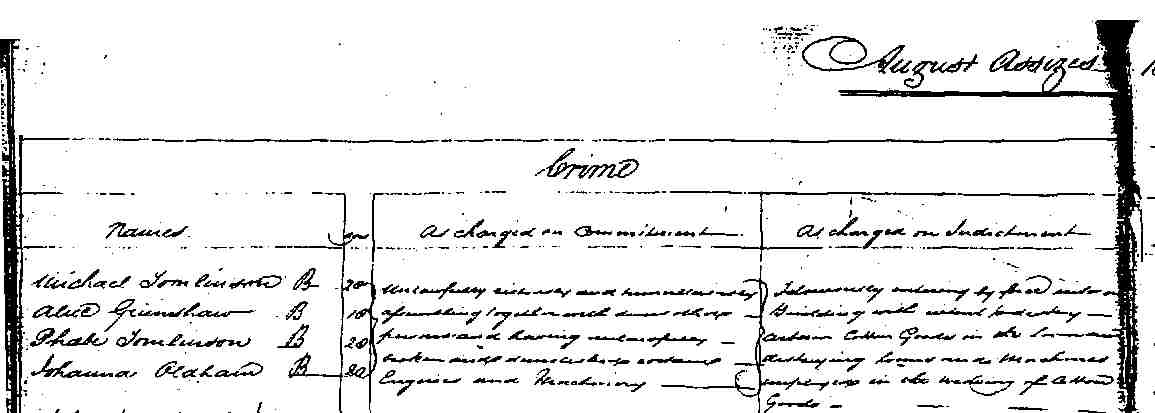
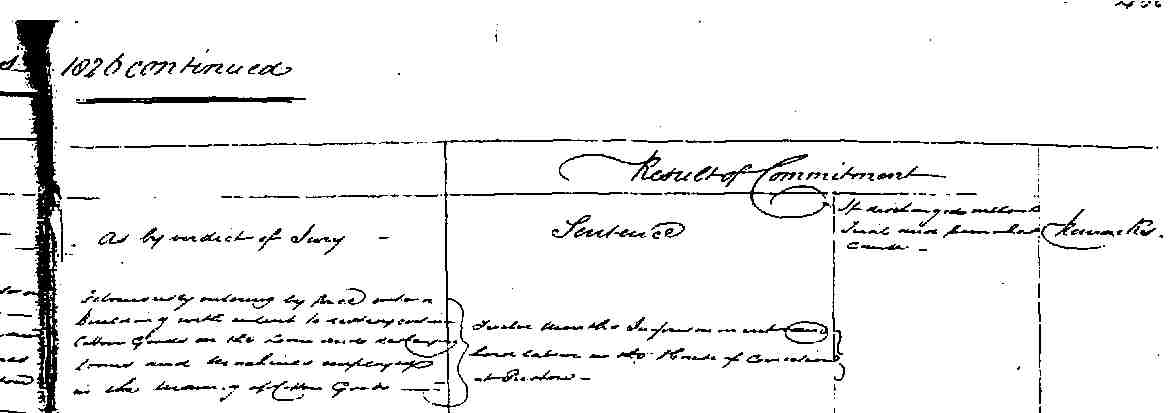
Figure 4. Eye-witness account by Ann Lonsdale of Phoebe Tomlinson’s part in the attack on White Ash factory 24 April 1826. Source: PRO PL27/10. Crown Copyright Public Record Office. The transcription is given below the image.
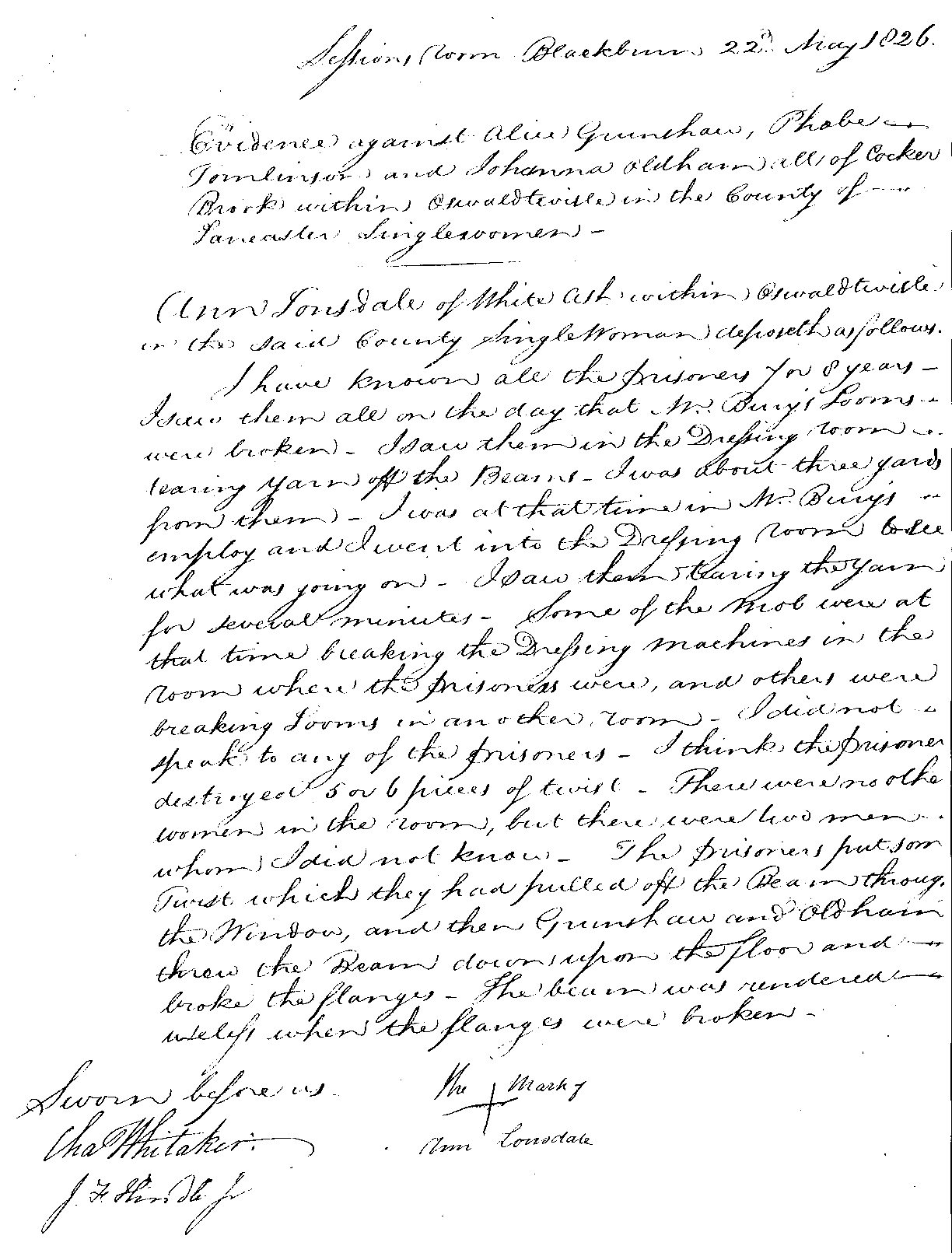
Transcription:
Sessions Room Blackburn 22 May 1826
Evidence against Alice Grimshaw, Phobe (sic) Tomlinson and Johanna Oldham all of Cocker Brook Oswaldtwistle in the County of Lancashire Singlewomen Ann Lonsdale of White Ash within oswaldtwistle in the said county Singlewoman deposeth as follows.
I have known all the prisoners for 8 years – I saw them all on the day that Mr Bury’s loooms were broken. I saw them in the Dressing room tearing yarn off the Beams. I was about three yards from them – I was at that time in Mr Bury’s employ and I went into the Dressing Room to see what was going on – I saw them tearing the yarn for several minutes – Some of the mob were at that time breaking the Dressing machines in the Room where the prisoners were, and others were breaking Looms in another room – I did not speak to any of the prisoners – I think the prisoners destroyed 5 or 6 pieces of twist. There were no other women in the room I did not know – The prisoners put some Twist which they had pulled off the Beam throgh the window, and then Grimshaw and Oldham
threw the Beam down upon the floor and broke the flanges – The beam was rendered useless when the flanges were broken.
Sworn before us
Chas. Whitaker
J.F. Hindle Her mark X Ann Lonsdale
Figure 5. Lancaster summer assizes document showing sentences for those arresting during the attack on White Ash factory 24 April 1826. The transcription is given below the image. Source: PRO PL27/31. Crown Copyright Public Record Office

Transcription:
Crimes
‘Feloniously breaking into a factory and demolishing machinery’ (top 7) ‘Feloniously breaking into a factory with intent to demolish it’ (Michael Tomlinson, Alice Grimshaw, Phoebe Tomlinson, Johanna Oldham – all sentenced to 12 months)
In the Crown Minute Books (PRO PL 28/5) Phoebe’s age is given as 28. She was, in fact, almost 27. Alice Grimshaw, her co-defendant, is listed as 18 years old. Phoebe now had a criminal record, that of: “feloniously breaking into a factory with intent to demolish it” (PRO HO 27/31). At the same time, seven others, including four women, were found guilty not only of breaking into a factory but also of demolishing machinery. They were sentenced to death. Phoebe got off lightly.
The next footprint in history that John leaves is his marriage to Phoebe Tomlinson, spinster and ten years his junior, on 26 May 1828 St. James’ in Church—the church where he had been christened. They were married by the curate, Steven Birkett. John signed his own name but Phoebe put a X—’her mark’. The witnesses were John Cropley and John Sleddon (or Sladdon or Haddon— the handwriting is unclear) but both had signed their names.
John returned to his occupation of his pre-army days, that of weaver, and moved from his home village of Church to the Red Shell area on the outskirts of nearby Oswaldtwistle. Red Shell Lane crosses the Haslingden to Blackburn Road (now the A677) linking the present B6231 (Oswaldtwistle to Lower Darwen road) to the B6232 in an almost straight line. It is marked on the present Ordnance Survey map as a track that becomes a public footpath past a cluster of farm buildings then a track again before joining the B6232.
The 1841 census shows John and Phoebe as living at White Croft (barely half a mile from Phoebe’s old home at Cocker Brook; see Figure 6) and John working as a ‘cotton weaver’. Phoebe does not have an occupation but by 1851 Phoebe is described as ‘cotton weaver’ and John now a ‘silk weaver’.
Figure 6. Cocker Brook, home place of Phoebe Tomlinson. (See Location 5 in Figure 1 above.)
Silk Weaver
By mid century, hand-loom weavers were more likely to be working in non-cotton trades. In the early nineteenth century there were about 170,000 hand-loom weavers, about a quarter of the working population of Lancashire, including Liverpool. By the latter part of the middle of the century there were around 55,000.
Was John’s change from cotton to silk a desperate move to stave off the encroaching technology of power looms that threatened the livelihoods of the hand-loom weavers? Was it now necessary, in 1851, for Phoebe to work as John could earn so little? Perhaps it was fortunate that they had no children. (Did John’s war wounds perhaps have something to do with their childlessness?) Perhaps, as an older person, John was reluctant to change to a totally new occupation or to factory work and simply switched from cotton weaving to silk weaving.
If the silk industry in Macclesfield, Cheshire, is anything to go by it may well be that in Lancashire also much of weaving was originally done by outworkers but by mid nineteenth century only work of the coarser kind was put out to the villages, the manufacturers preferring to keep the manufacture of the finer goods close under their eye in factories.
Neighbours
Census returns of 1841 and parish registers show more Grimshaws living in the Red Shell area but it has not been possible to establish exact relationships (if any) with John Grimshaw.
They included William and Dorothy (née Chambers and daughter of John and Dolly Chambers) Grimshaw and their children Alice (born 1802), John (born 1803), Mary (born 1807), Elizabeth (born 1809), Esther (born 1810), Ann (born 1813), William (born 1815), Ellen (born 1817) and Maria (born 1818). The family had moved from Houlker Barn (to the east of Red Shell Lane) to Red Shell about 1808.
Richard and Betty (née Haworth) Grimshaw and Richard and Elizabeth (née Holden) with fourteen children between them: Peter (born 1783), Betty (1785), Ellen 1788), George (1788) Timothy (1790), James (1792), two James (1792), John (1794), Richard (1796), Mally (1798), Doctor (1802), Anne (1804) and Thomas (1809). Here, Doctor is a Christian name, not an occupation.
In the 1841 census there was also a James Grimshaw and his wife, Mary, also a silk weaver, living quite close by, and on Red Shell Lane itself lived more Grimshaws headed by Sheppard Grimshaw. (They do not appear in the 1851 census). To the east across the moor at Redwalls were yet more Grimshaws, a family headed by Rishton Grimshaw. They were also there in 1851.
The census also shows Phoebe’s brother, John, his wife, Alice, and their eight children living close by at Broughton Barn (see Figure 7.) Not far away at Hey Nook lived her other brother, William, and his wife, Ann, with their two children, Emmanuel and Betty.
Figure 7a. Broughton Barn, home of John and Alice Tomlinson. John was the brother-in-law of John Grimshaw (i.e., he was Phoebe Tomlinson’s brother.) (See Location 4 in Figure 1 above.) Photos provided by Anne Grimshaw.
Figure 7b. Cottages near Broughton Barn, home of John and Alice Tomlinson.
Thomas Pollard
Thomas was more than simply John’s brother-in-law—he too had been a Coldstream Guardsman having enlisted on 7 October 1803 and started out in Lt Col. W. Sheridan’s Company. He was transferred to the 1st Battalion, served in the Peninsula War before being “wounded in the right hand not having the perfect use of it” according to his discharge papers (PRO WO 97/200) and considered unfit for further service on 8 September 1814 after serving almost eleven years. He had signed his discharge paper with his signature, not a X. It is, therefore, a little strange that he had put an X when informing the authorities of the death of John Grimshaw. (In this age of only partial literacy, some considered an X to be more authoritative than a signature.)
Thomas was born in the parish of Simmonster [Simonstone?] near Burnley . He was described as 5 feet 7 inches tall with dark hair, grey eyes, a fresh complexion and a labourer by trade.
When Thomas’s time came, eight years after John, he was buried quite close to the church of St James’, Church, with his wife, Sally who had preceded him by almost exactly a year, and their young daughter, Sarah. Seven years later, daughter-in-law, Margaret was buried there too. The gravestone for Thomas, Sally and Margaret is shown in Figure 8.
Figure 8. Gravestone of Thomas Pollard, his wife Sally (Grimshaw) Pollard (John Grimshaw’s sister) and their daughter-in-law, Margaret (wife of the son of Thomas and Sally Pollard.) Located at St James’ Church. (See Location 2 in Figure 1 above.)
The inscription for Thomas reads as follows:
“Sacred to the memory of the late Thomas Pollard, Pensioner of the Coldstream Regiment of Footguards, enlisted in 1803 and returned in 1814 and was through the whole of the Peninsular War under the command of his excellency the Duke of Wellington, born March 24th 1786 and died on the 21st of December 1859.”
Also, note the two Cap Star emblems of the Coldstream Guards at the beginning of the inscription for Thomas. The inscriptions for his wife, Sally, and daughter-in-law, Margaret, can also be read below that of Thomas. Photo provided by Anne Grimshaw.
It is a mystery how and why a former Coldstream Guardsman, semi-literate and listed as a labourer in the 1851 census, should have (or could afford) a rather grand tomb-like grave with elegant inscription and adorned by the badge of the Coldstream Guards in a prime position in the churchyard.
As Thomas was just three years older than John, is it possible that John used Thomas as a role model and followed his example of joining the same regiment? When Thomas married John’s sister on 4 December 1815, the bond between the two families was further strengthened.
In the 1881 census (thirty years after John’s death) Thomas Pollard, John’s nephew, the son of Thomas, who reported his death, was living at 110 Henry Street, Church. Across the road at number 81 lived William Grimshaw possibly another relative—a generation younger. No 110 Henry Street has been demolished and in its place is a small block of flats. However, 81 Henry Street still stands—the end house of a short terrace of stone cottages. Perhaps Thomas Pollard’s house would have been similar.
Webpage History
Webpage posted January 2002. Banner replaced April 2011.
